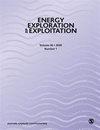Green mechanism: Opportunities for corporate investment in PV/battery/diesel hybrid systems with techno-economic and environmental analysis
IF 1.6
4区 工程技术
Q4 ENERGY & FUELS
引用次数: 0
Abstract
In rural areas, diesel generators are prevalent due to their lower initial cost, despite inefficiencies and carbon emissions. Transitioning to PV/Battery/Diesel systems offers a solution by reducing costs and emissions. However, the high upfront expenses present a significant barrier, particularly for rural communities, necessitating external financial support. This study evaluates the benefits of adopting a PV/Battery/Diesel hybrid system over traditional diesel generators in a rural community with 25 customers and a daily demand of 50 kWh. The proposed system includes a 12 kWp photovoltaic array and a 48 kWh battery bank, simulated using Hybrid Optimization of Multiple Energy Resources (HOMER) software. Results indicate a 91% renewable fraction and a cost of energy of 0.279 USD/kWh, substantially lower than the 1.05 USD/kWh of diesel-only systems, with CO绿色机制:光伏/电池/柴油混合动力系统的企业投资机会,包括技术经济和环境分析
在农村地区,柴油发电机虽然效率低、碳排放量大,但由于初始成本较低,因此非常普遍。过渡到光伏/电池/柴油系统可降低成本和排放,从而提供一种解决方案。然而,高昂的前期费用是一个重大障碍,特别是对于农村社区而言,需要外部资金支持。本研究评估了在一个拥有 25 个用户、日需求量为 50 千瓦时的农村社区采用光伏/电池/柴油混合系统而非传统柴油发电机的好处。拟议的系统包括一个 12 kWp 的光伏阵列和一个 48 kWh 的电池组,使用多能源资源混合优化(HOMER)软件进行模拟。结果表明,该系统的可再生能源比例为 91%,能源成本为 0.279 美元/千瓦时,大大低于纯柴油系统的 1.05 美元/千瓦时,每年可节约 25 吨二氧化碳。论文提倡采用案例研究的方法来研究绿色机制,敦促能源和环保公司投资这些系统。通过用光伏/柴油/电池混合系统取代柴油发电机,企业可以以更低的成本提供电力,从而推动系统的采用。通过出售减排产生的碳信用额度,可以利用二氧化碳税收优惠政策创造额外收入。在投资者承担 50% 柴油成本的情况下,出售电力每年可获得 9581 美元,出售二氧化碳信用额每年可获得 500 美元。因此,在不使用二氧化碳信用额度的情况下,投资回收期为 9.83 年;在使用二氧化碳信用额度的情况下,投资回收期为 9.18 年;在项目生命周期内,在不使用二氧化碳信用额度的情况下,投资回收期为 46848 美元;在使用二氧化碳信用额度的情况下,投资回收期为 52927 美元。同时,将电价调整为柴油成本的 75%,每年的售电收入将增加到 14 372 美元。这样,在不使用二氧化碳信用额度的情况下,投资回收期缩短为 5.89 年;在使用二氧化碳信用额度的情况下,投资回收期缩短为 5.66 年;在项目结束时,在不使用二氧化碳信用额度的情况下,投资回收期为 105,094 美元;在使用二氧化碳信用额度的情况下,投资回收期为 111,174 美元。
本文章由计算机程序翻译,如有差异,请以英文原文为准。
求助全文
约1分钟内获得全文
求助全文
来源期刊

Energy Exploration & Exploitation
工程技术-能源与燃料
CiteScore
5.40
自引率
3.70%
发文量
78
审稿时长
3.9 months
期刊介绍:
Energy Exploration & Exploitation is a peer-reviewed, open access journal that provides up-to-date, informative reviews and original articles on important issues in the exploration, exploitation, use and economics of the world’s energy resources.
 求助内容:
求助内容: 应助结果提醒方式:
应助结果提醒方式:


